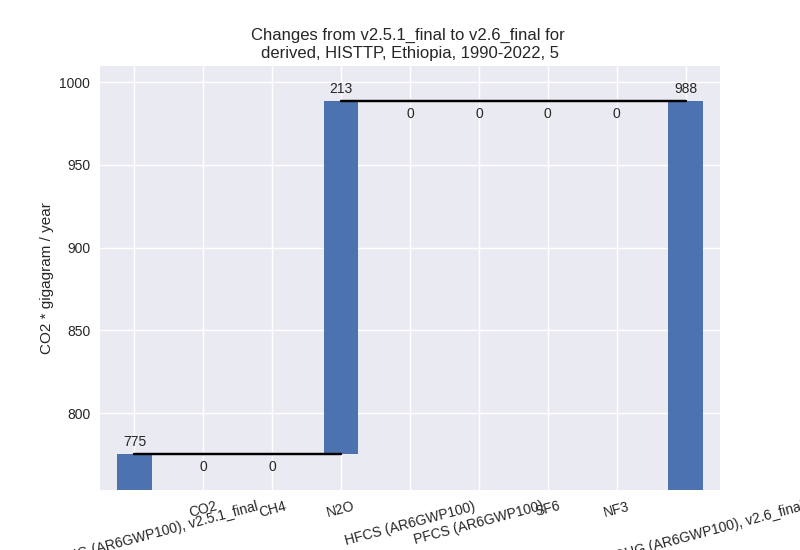Changes in PRIMAP-hist v2.6_final compared to v2.5.1_final for Ethiopia
2024-09-24
Johannes Gütschow
Change analysis for Ethiopia for PRIMAP-hist v2.6_final compared to v2.5.1_final
Overview over emissions by sector and gas
The following figures show the aggregate national total emissions excluding LULUCF AR6GWP100 for the country reported priority scenario. The dotted linesshow the v2.5.1_final data.
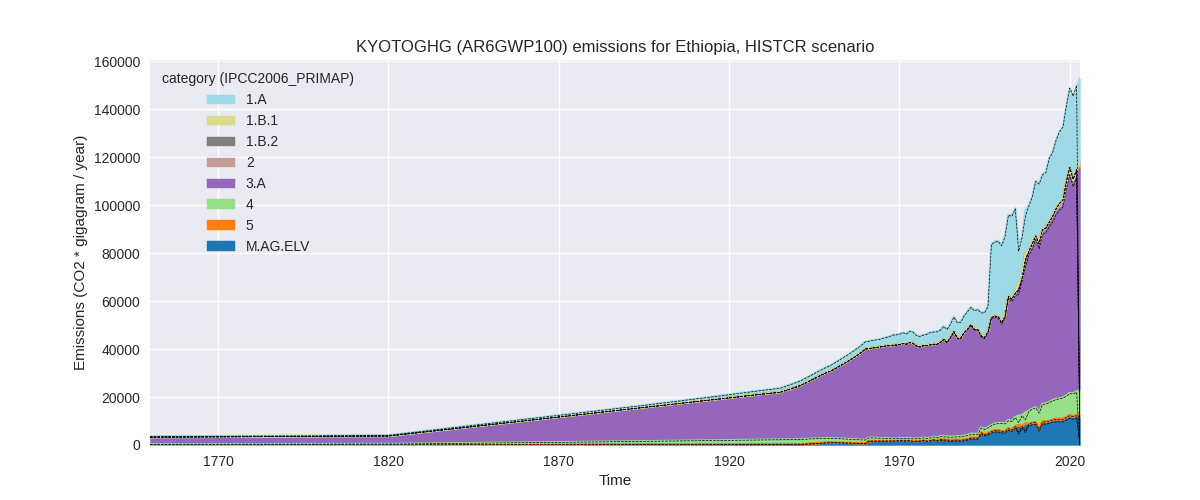
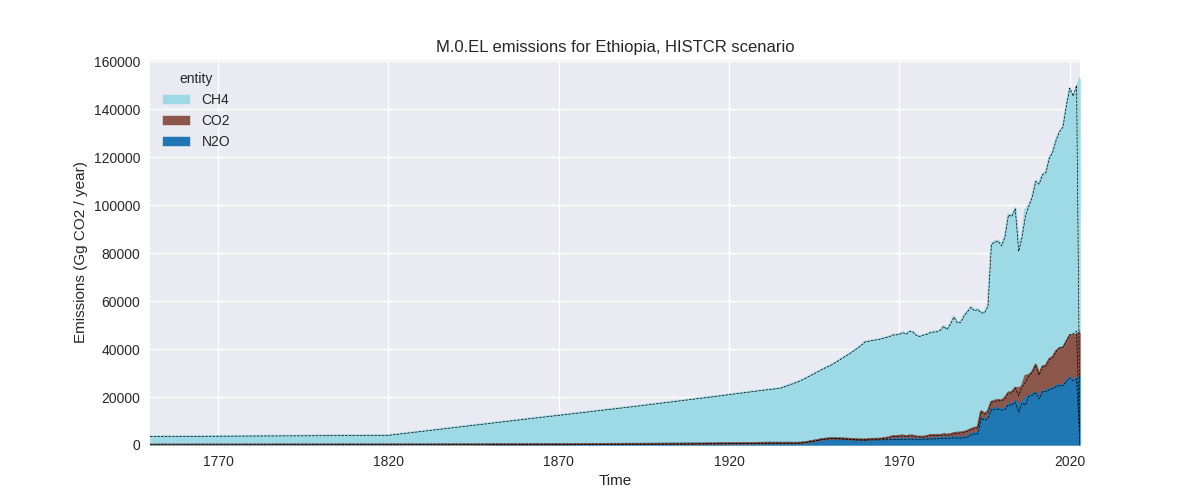
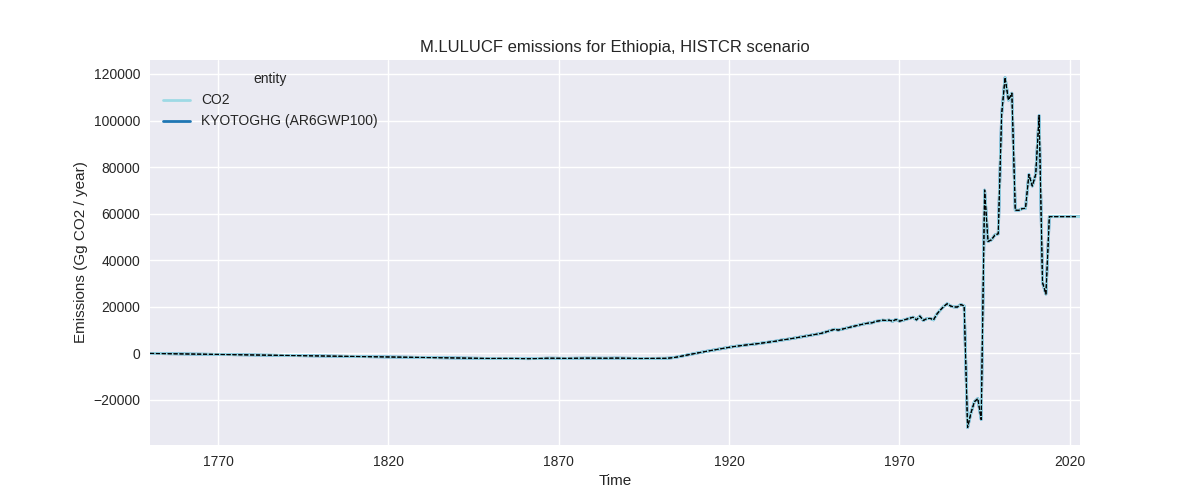
The following figures show the aggregate national total emissions excluding LULUCF AR6GWP100 for the third party priority scenario. The dotted linesshow the v2.5.1_final data.
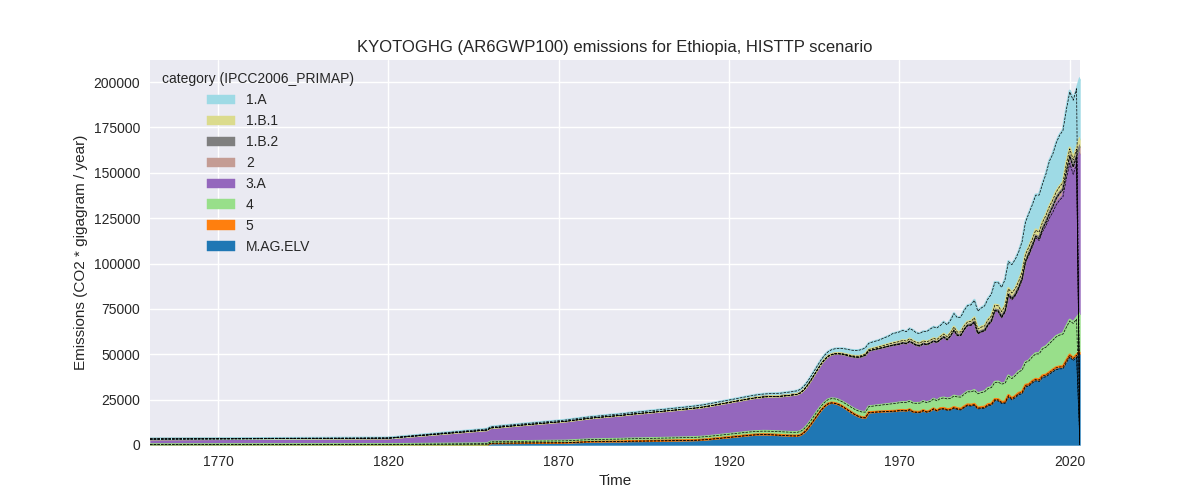
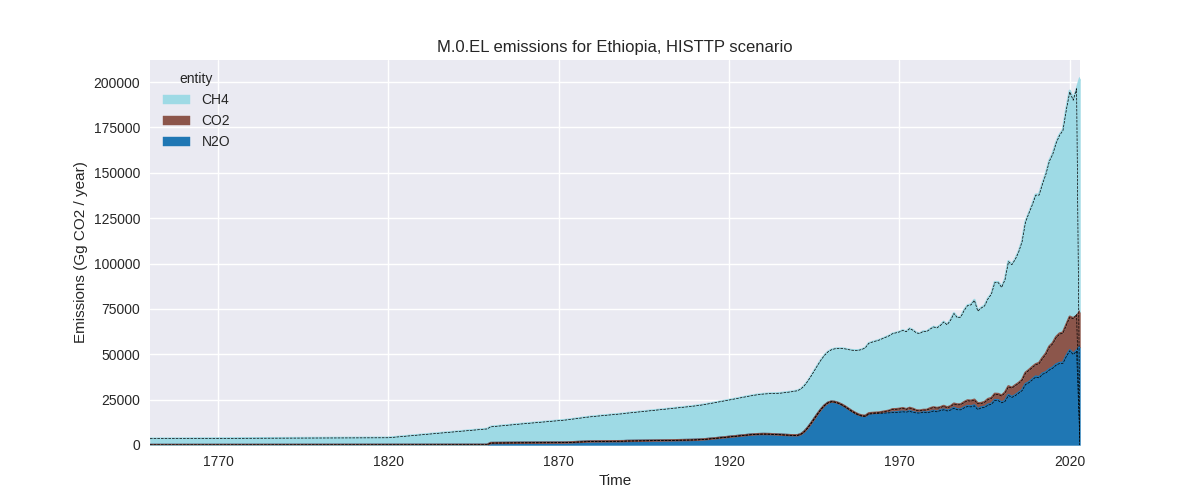
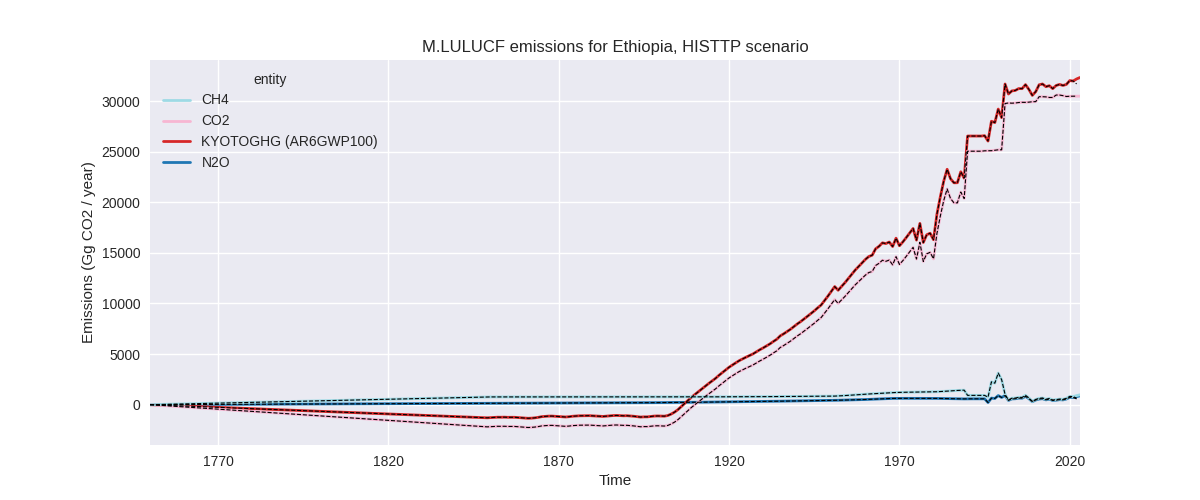
Overview over changes
In the country reported priority scenario we have the following changes for aggregate Kyoto GHG and national total emissions excluding LULUCF (M.0.EL):
- Emissions in 2022 have changed by -1.1%% (-1601.20 Gg CO2 / year)
- Emissions in 1990-2022 have changed by 0.3%% (246.49 Gg CO2 / year)
In the third party priority scenario we have the following changes for aggregate Kyoto GHG and national total emissions excluding LULUCF (M.0.EL):
- Emissions in 2022 have changed by -0.3%% (-508.25 Gg CO2 / year)
- Emissions in 1990-2022 have changed by 0.2%% (263.79 Gg CO2 / year)
Most important changes per scenario and time frame
In the country reported priority scenario the following sector-gas combinations have the highest absolute impact on national total KyotoGHG (AR6GWP100) emissions in 2022 (top 5):
- 1: 1.A, CO2 with -1189.48 Gg CO2 / year (-7.2%)
- 2: 2, CO2 with -692.16 Gg CO2 / year (-22.3%)
- 3: 5, N2O with 230.86 Gg CO2 / year (21.0%)
- 4: 4, N2O with -156.82 Gg CO2 / year (-11.1%)
- 5: 4, CH4 with 154.04 Gg CO2 / year (1.9%)
In the country reported priority scenario the following sector-gas combinations have the highest absolute impact on national total KyotoGHG (AR6GWP100) emissions in 1990-2022 (top 5):
- 1: 5, N2O with 213.33 Gg CO2 / year (27.5%)
- 2: M.AG.ELV, N2O with 177.46 Gg CO2 / year (3.2%)
- 3: 2, CO2 with -90.61 Gg CO2 / year (-6.0%)
- 4: 1.A, CO2 with -36.83 Gg CO2 / year (-0.5%)
- 5: 4, N2O with -23.98 Gg CO2 / year (-2.8%)
In the third party priority scenario the following sector-gas combinations have the highest absolute impact on national total KyotoGHG (AR6GWP100) emissions in 2022 (top 5):
- 1: 1.A, CO2 with -1142.04 Gg CO2 / year (-7.2%)
- 2: 4, CH4 with 344.53 Gg CO2 / year (1.9%)
- 3: 5, N2O with 230.86 Gg CO2 / year (21.0%)
- 4: 4, N2O with 57.10 Gg CO2 / year (4.3%)
- 5: 1.B.2, CO2 with 5.78 Gg CO2 / year (105.1%)
In the third party priority scenario the following sector-gas combinations have the highest absolute impact on national total KyotoGHG (AR6GWP100) emissions in 1990-2022 (top 5):
- 1: 5, N2O with 213.33 Gg CO2 / year (27.5%)
- 2: 4, N2O with 52.93 Gg CO2 / year (6.7%)
- 3: 1.A, CO2 with -35.37 Gg CO2 / year (-0.5%)
- 4: 4, CH4 with 33.00 Gg CO2 / year (0.3%)
- 5: 2, CO2 with -0.64 Gg CO2 / year (-0.0%)
Notes on data changes
Here we list notes explaining important emissions changes for the country. ’' means that the following text only applies to the TP time series, while means that it only applies to the CR scenario. Otherwise the note applies to both scenarios.
- We have no new country reported data for Ethiopia, but a small change in processing where we removed partial data for agricultural N2O. Further changes are in energy CO2 due to updated third party data.
- Overall emissions have changed by less than 1% for both 2022 and 1990-2022.
- Changes for the third party time series are limited to energy and cement CO2.
Changes by sector and gas
For each scenario and time frame the changes are displayed for all individual sectors and all individual gases. In the sector plot we use aggregate Kyoto GHGs in AR6GWP100. In the gas plot we usenational total emissions without LULUCF. ## country reported scenario
2022
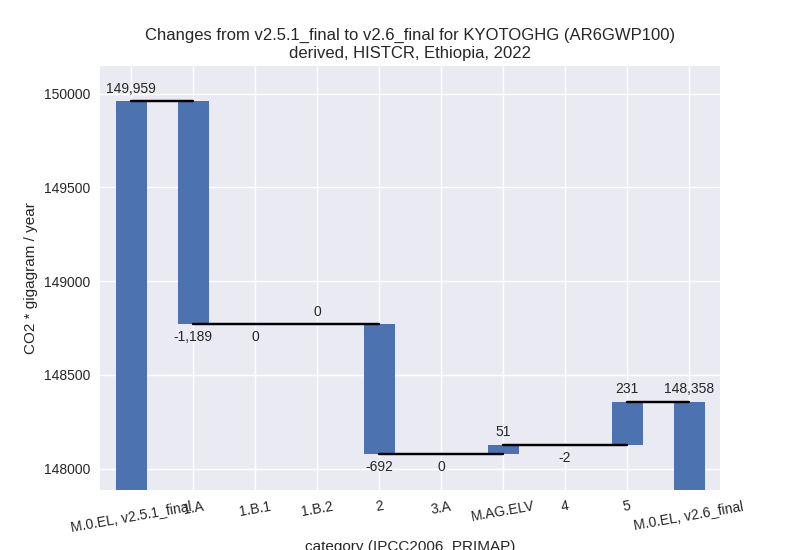
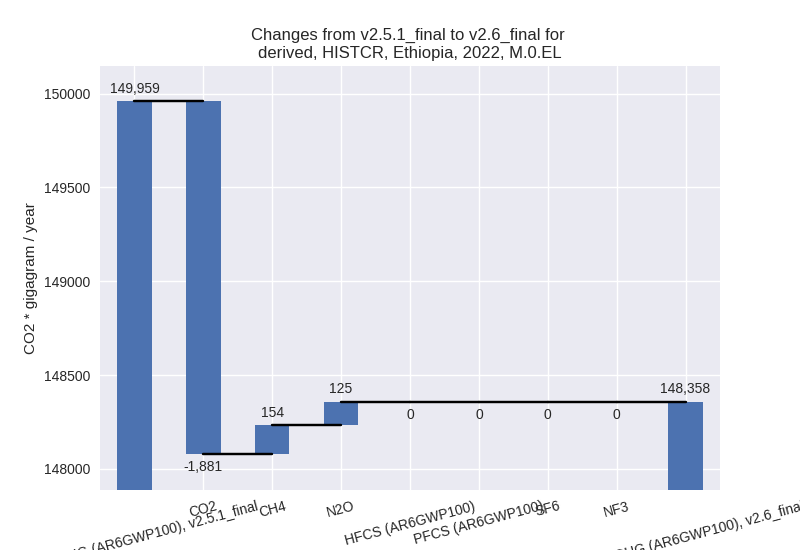
1990-2022
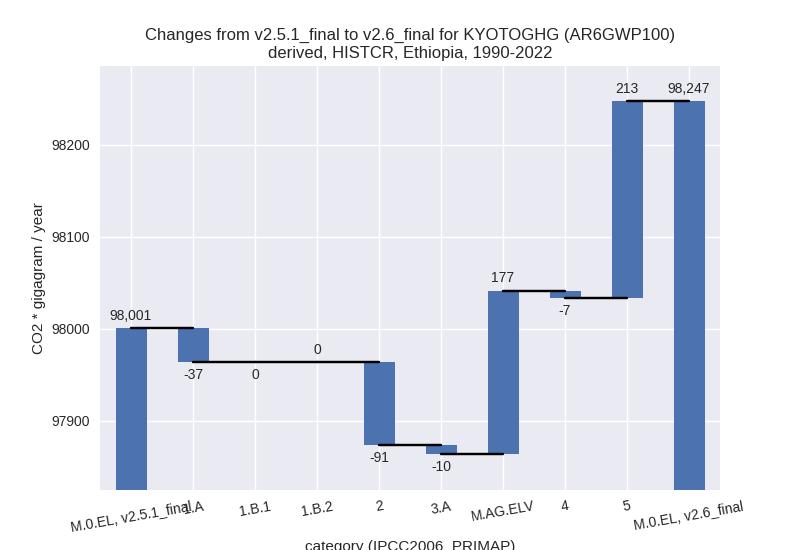
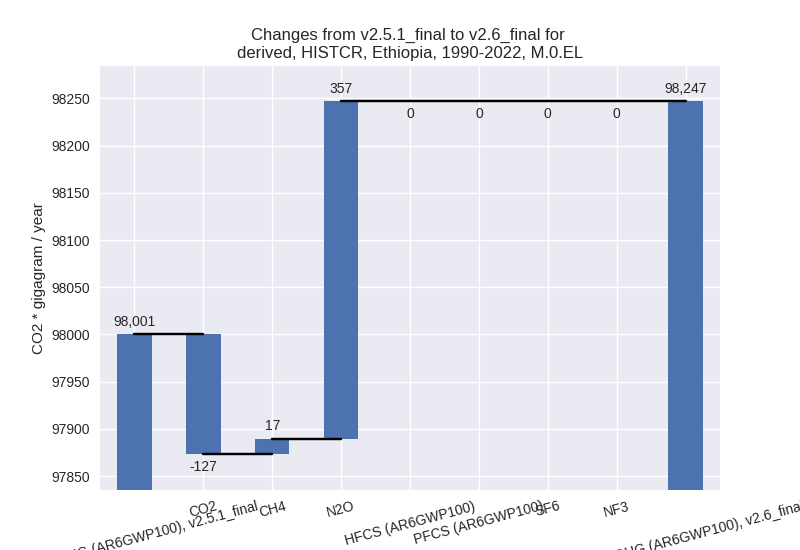
third party scenario
2022
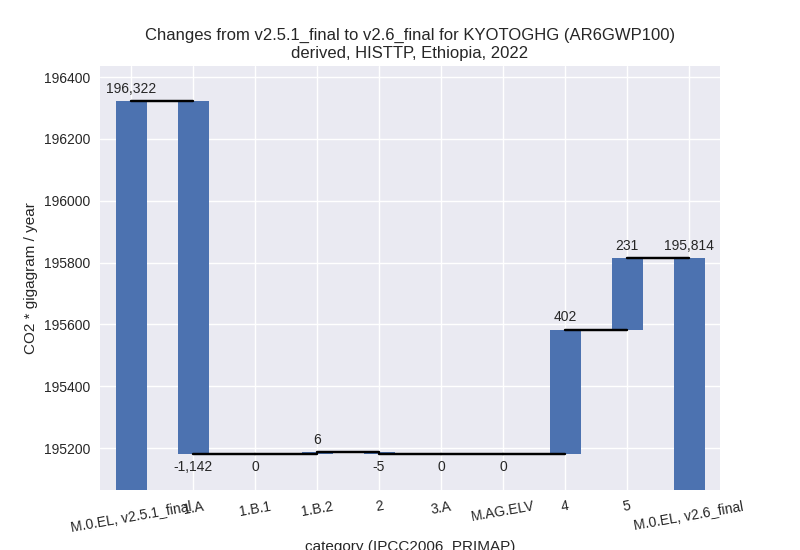
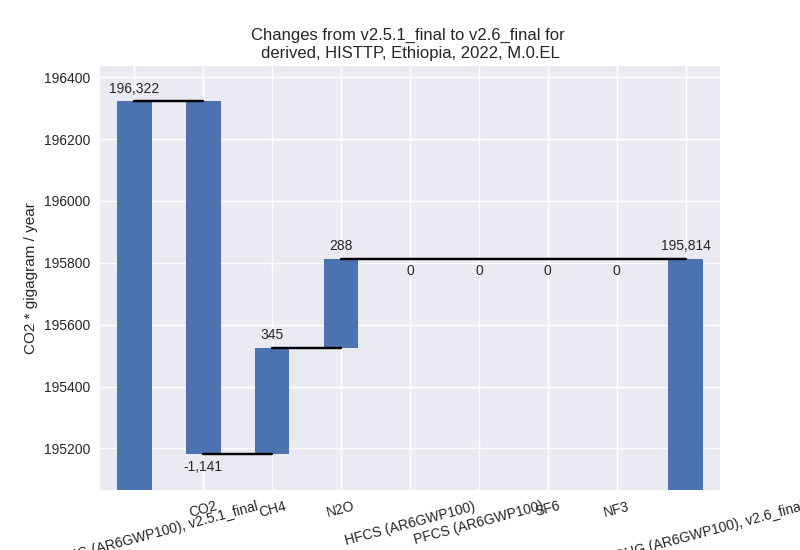
1990-2022

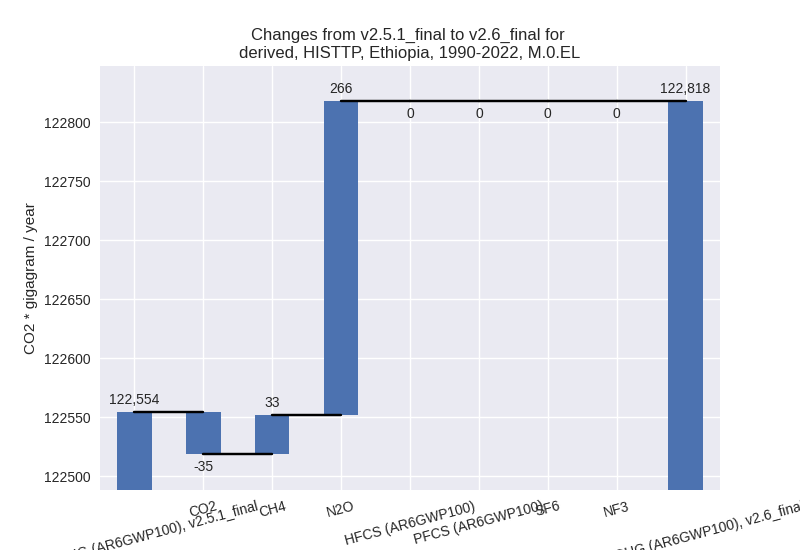
Detailed changes for the scenarios:
country reported scenario (HISTCR):
Most important changes per time frame
For 2022 the following sector-gas combinations have the highest absolute impact on national total KyotoGHG (AR6GWP100) emissions in 2022 (top 5):
- 1: 1.A, CO2 with -1189.48 Gg CO2 / year (-7.2%)
- 2: 2, CO2 with -692.16 Gg CO2 / year (-22.3%)
- 3: 5, N2O with 230.86 Gg CO2 / year (21.0%)
- 4: 4, N2O with -156.82 Gg CO2 / year (-11.1%)
- 5: 4, CH4 with 154.04 Gg CO2 / year (1.9%)
For 1990-2022 the following sector-gas combinations have the highest absolute impact on national total KyotoGHG (AR6GWP100) emissions in 1990-2022 (top 5):
- 1: 5, N2O with 213.33 Gg CO2 / year (27.5%)
- 2: M.AG.ELV, N2O with 177.46 Gg CO2 / year (3.2%)
- 3: 2, CO2 with -90.61 Gg CO2 / year (-6.0%)
- 4: 1.A, CO2 with -36.83 Gg CO2 / year (-0.5%)
- 5: 4, N2O with -23.98 Gg CO2 / year (-2.8%)
Changes in the main sectors for aggregate KyotoGHG (AR6GWP100) are
- 1: Total sectoral emissions in 2022 are 34050.84 Gg
CO2 / year which is 23.0% of M.0.EL emissions. 2022 Emissions have
changed by -3.4% (-1189.46 Gg CO2 /
year). 1990-2022 Emissions have changed by -0.2% (-36.83 Gg CO2 / year). For 2022 the
changes per gas
are:
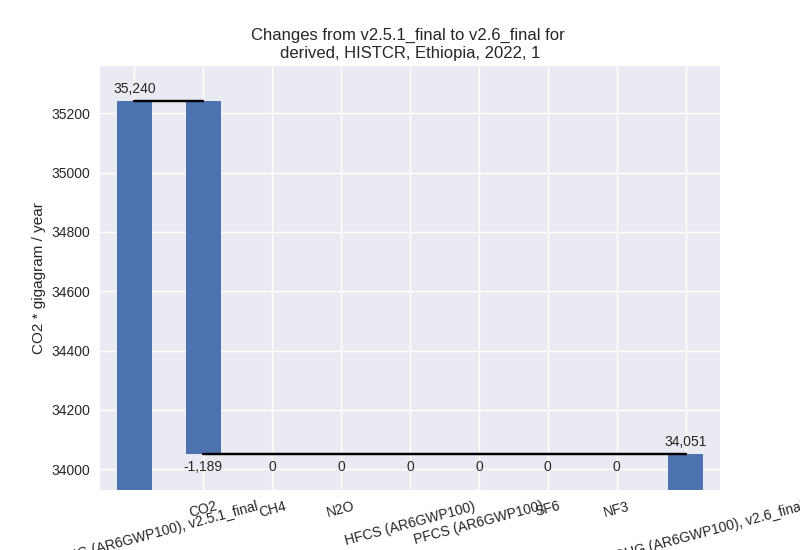
The changes come from the following subsectors:- 1.A: Total sectoral emissions in 2022 are 33984.98
Gg CO2 / year which is 99.8% of category 1 emissions. 2022 Emissions
have changed by -3.4% (-1189.48 Gg
CO2 / year). 1990-2022 Emissions have changed by -0.2% (-36.83 Gg CO2 / year). For 2022 the
changes per gas
are:
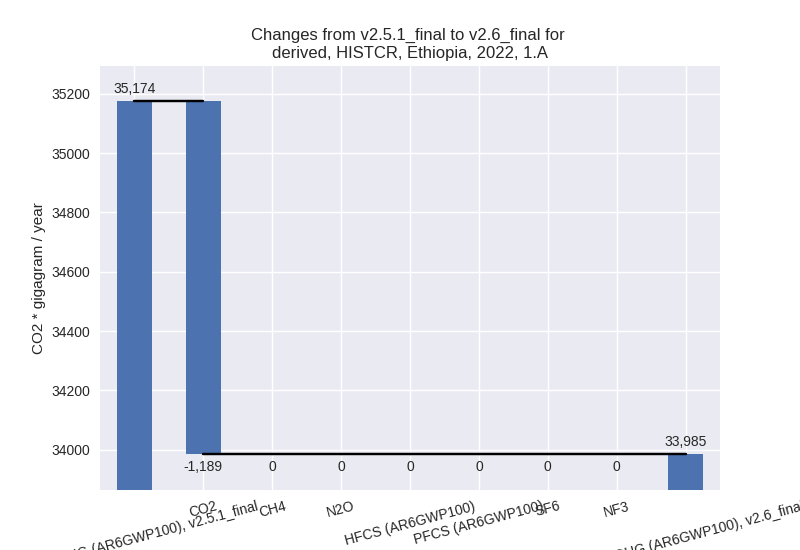
There is no subsector information available in PRIMAP-hist. - 1.B.1: Total sectoral emissions in 2022 are 64.73 Gg CO2 / year which is 0.2% of category 1 emissions. 2022 Emissions have changed by 0.0% (0.00 Gg CO2 / year). 1990-2022 Emissions have changed by 0.0% (0.00 Gg CO2 / year).
- 1.B.2: Total sectoral emissions in 2022 are 1.12 Gg CO2 / year which is 0.0% of category 1 emissions. 2022 Emissions have changed by 1.8% (0.02 Gg CO2 / year). 1990-2022 Emissions have changed by 0.3% (0.00 Gg CO2 / year).
- 1.A: Total sectoral emissions in 2022 are 33984.98
Gg CO2 / year which is 99.8% of category 1 emissions. 2022 Emissions
have changed by -3.4% (-1189.48 Gg
CO2 / year). 1990-2022 Emissions have changed by -0.2% (-36.83 Gg CO2 / year). For 2022 the
changes per gas
are:
- 2: Total sectoral emissions in 2022 are 2406.36 Gg
CO2 / year which is 1.6% of M.0.EL emissions. 2022 Emissions have
changed by -22.3% (-692.16 Gg CO2 /
year). 1990-2022 Emissions have changed by -6.0% (-90.61 Gg CO2 / year). For 2022 the
changes per gas
are:
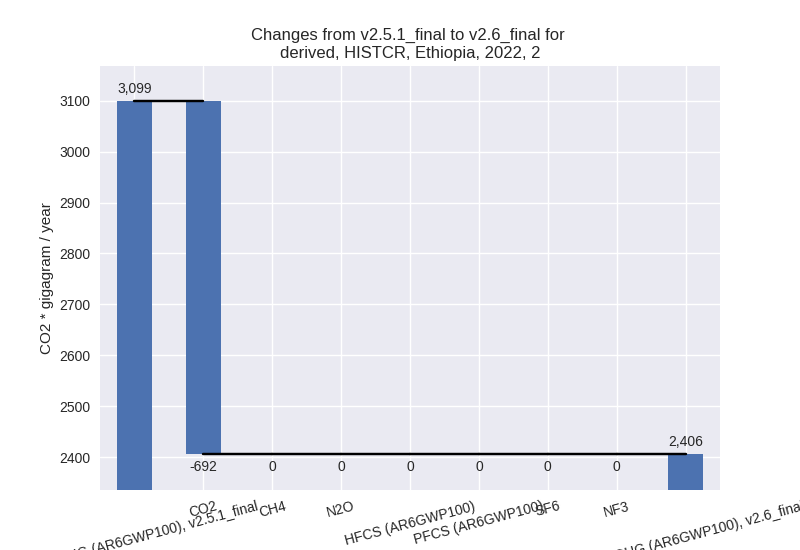
For 1990-2022 the changes per gas are: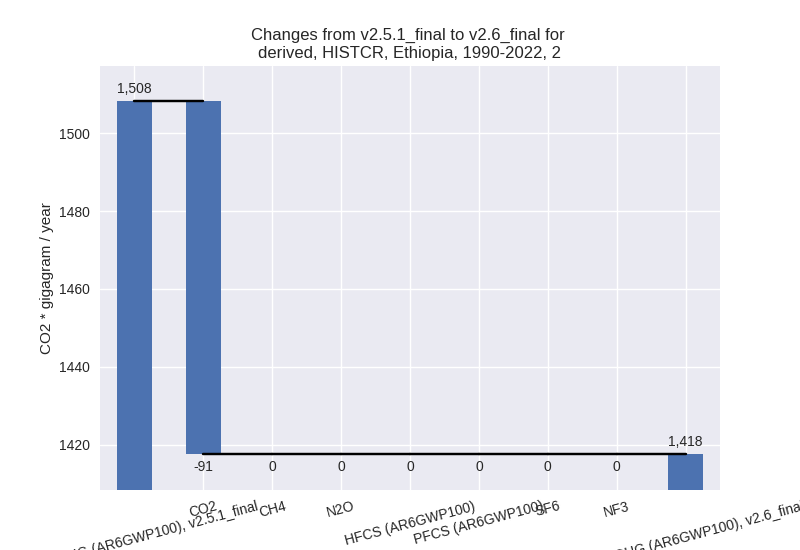
- M.AG: Total sectoral emissions in 2022 are 100829.59 Gg CO2 / year which is 68.0% of M.0.EL emissions. 2022 Emissions have changed by 0.1% (51.44 Gg CO2 / year). 1990-2022 Emissions have changed by 0.3% (167.85 Gg CO2 / year).
- 4: Total sectoral emissions in 2022 are 9740.08 Gg CO2 / year which is 6.6% of M.0.EL emissions. 2022 Emissions have changed by -0.0% (-1.89 Gg CO2 / year). 1990-2022 Emissions have changed by -0.1% (-7.24 Gg CO2 / year).
- 5: Total sectoral emissions in 2022 are 1330.93 Gg
CO2 / year which is 0.9% of M.0.EL emissions. 2022 Emissions have
changed by 21.0% (230.86 Gg CO2 /
year). 1990-2022 Emissions have changed by 27.5% (213.33 Gg CO2 / year). For 2022 the
changes per gas
are:

For 1990-2022 the changes per gas are:
third party scenario (HISTTP):
Most important changes per time frame
For 2022 the following sector-gas combinations have the highest absolute impact on national total KyotoGHG (AR6GWP100) emissions in 2022 (top 5):
- 1: 1.A, CO2 with -1142.04 Gg CO2 / year (-7.2%)
- 2: 4, CH4 with 344.53 Gg CO2 / year (1.9%)
- 3: 5, N2O with 230.86 Gg CO2 / year (21.0%)
- 4: 4, N2O with 57.10 Gg CO2 / year (4.3%)
- 5: 1.B.2, CO2 with 5.78 Gg CO2 / year (105.1%)
For 1990-2022 the following sector-gas combinations have the highest absolute impact on national total KyotoGHG (AR6GWP100) emissions in 1990-2022 (top 5):
- 1: 5, N2O with 213.33 Gg CO2 / year (27.5%)
- 2: 4, N2O with 52.93 Gg CO2 / year (6.7%)
- 3: 1.A, CO2 with -35.37 Gg CO2 / year (-0.5%)
- 4: 4, CH4 with 33.00 Gg CO2 / year (0.3%)
- 5: 2, CO2 with -0.64 Gg CO2 / year (-0.0%)
Changes in the main sectors for aggregate KyotoGHG (AR6GWP100) are
- 1: Total sectoral emissions in 2022 are 36271.43 Gg
CO2 / year which is 18.5% of M.0.EL emissions. 2022 Emissions have
changed by -3.0% (-1136.25 Gg CO2 /
year). 1990-2022 Emissions have changed by -0.2% (-34.84 Gg CO2 / year). For 2022 the
changes per gas
are:
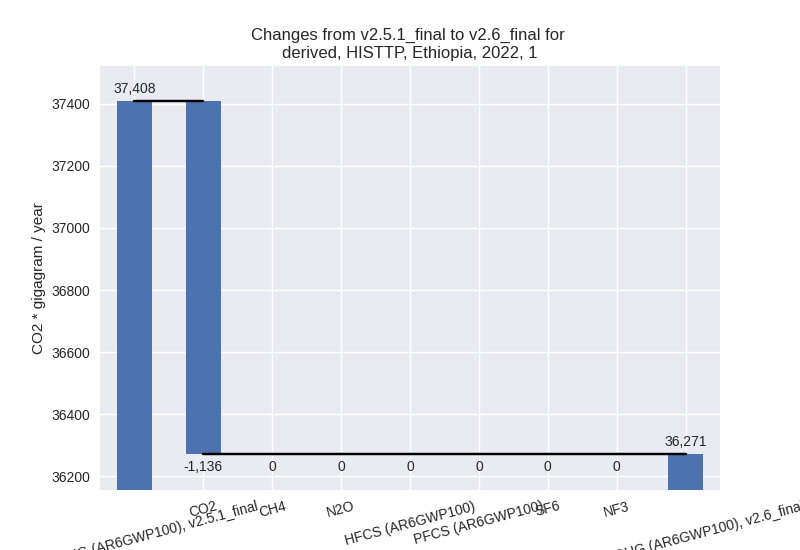
The changes come from the following subsectors:- 1.A: Total sectoral emissions in 2022 are 32224.09
Gg CO2 / year which is 88.8% of category 1 emissions. 2022 Emissions
have changed by -3.4% (-1142.04 Gg
CO2 / year). 1990-2022 Emissions have changed by -0.2% (-35.37 Gg CO2 / year). For 2022 the
changes per gas
are:
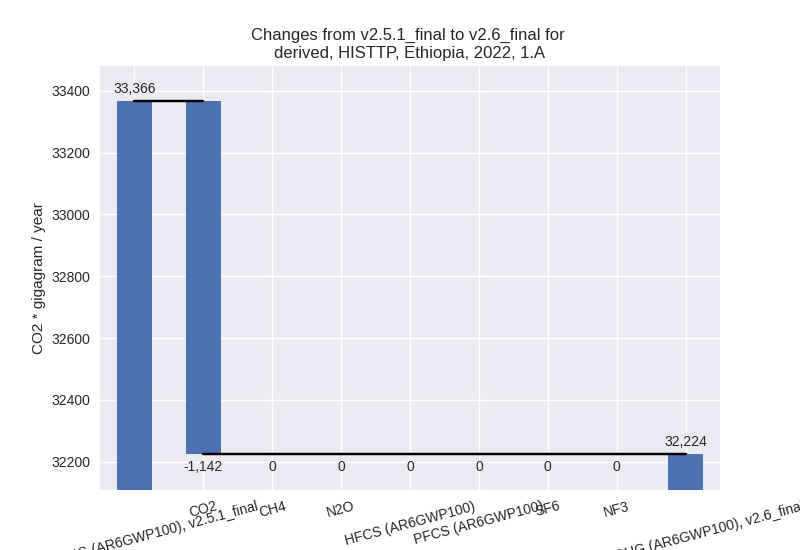
There is no subsector information available in PRIMAP-hist. - 1.B.1: Total sectoral emissions in 2022 are 4035.72 Gg CO2 / year which is 11.1% of category 1 emissions. 2022 Emissions have changed by 0.0% (0.00 Gg CO2 / year). 1990-2022 Emissions have changed by 0.0% (0.00 Gg CO2 / year).
- 1.B.2: Total sectoral emissions in 2022 are 11.61
Gg CO2 / year which is 0.0% of category 1 emissions. 2022 Emissions have
changed by 99.2% (5.78 Gg CO2 /
year). 1990-2022 Emissions have changed by 18.9% (0.53 Gg CO2 / year). For 2022 the
changes per gas
are:
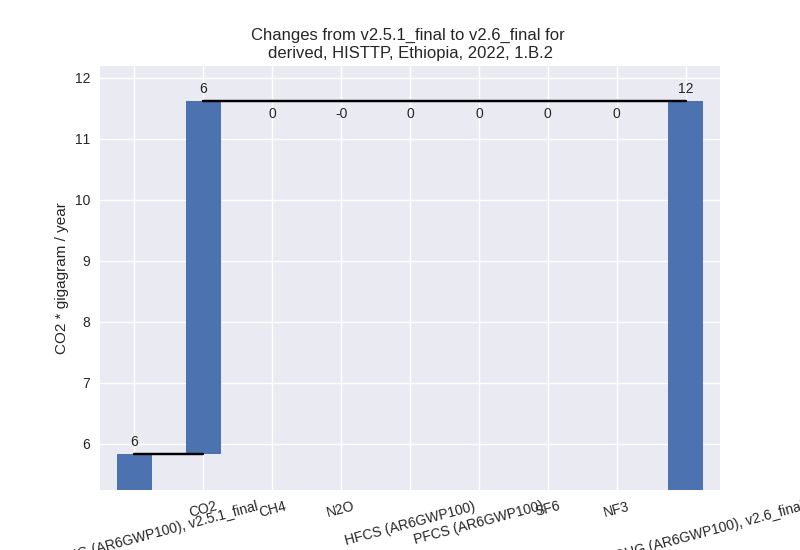
For 1990-2022 the changes per gas are: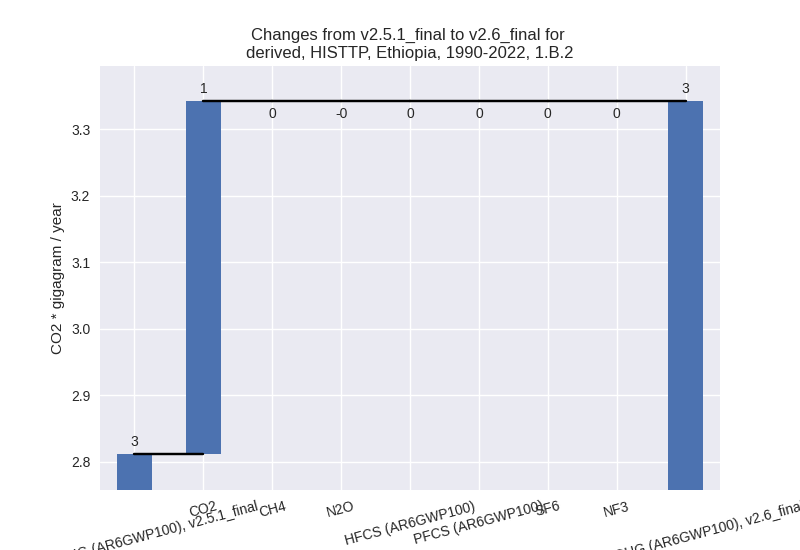
There is no subsector information available in PRIMAP-hist.
- 1.A: Total sectoral emissions in 2022 are 32224.09
Gg CO2 / year which is 88.8% of category 1 emissions. 2022 Emissions
have changed by -3.4% (-1142.04 Gg
CO2 / year). 1990-2022 Emissions have changed by -0.2% (-35.37 Gg CO2 / year). For 2022 the
changes per gas
are:
- 2: Total sectoral emissions in 2022 are 3972.11 Gg CO2 / year which is 2.0% of M.0.EL emissions. 2022 Emissions have changed by -0.1% (-4.57 Gg CO2 / year). 1990-2022 Emissions have changed by -0.0% (-0.64 Gg CO2 / year).
- M.AG: Total sectoral emissions in 2022 are 133930.56 Gg CO2 / year which is 68.4% of M.0.EL emissions. 2022 Emissions have changed by 0.0% (0.00 Gg CO2 / year). 1990-2022 Emissions have changed by 0.0% (0.00 Gg CO2 / year).
- 4: Total sectoral emissions in 2022 are 20308.70 Gg
CO2 / year which is 10.4% of M.0.EL emissions. 2022 Emissions have
changed by 2.0% (401.71 Gg CO2 /
year). 1990-2022 Emissions have changed by 0.7% (85.93 Gg CO2 / year). For 2022 the
changes per gas
are:
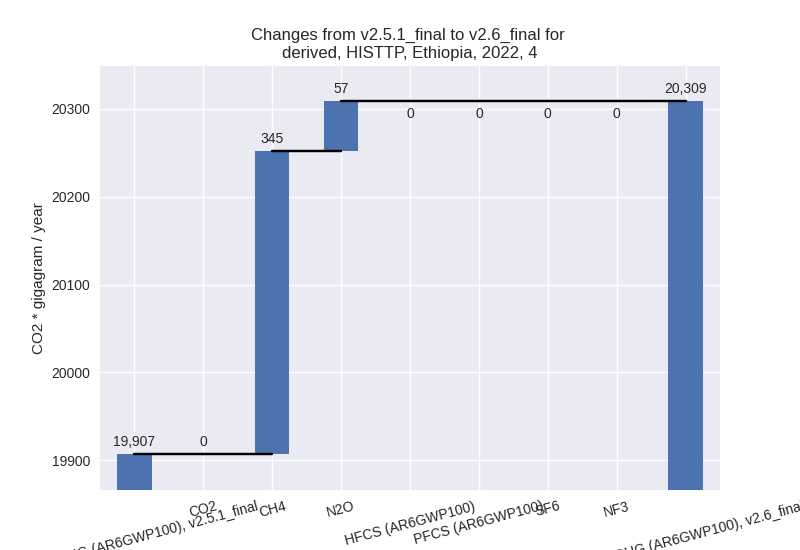
- 5: Total sectoral emissions in 2022 are 1330.93 Gg
CO2 / year which is 0.7% of M.0.EL emissions. 2022 Emissions have
changed by 21.0% (230.86 Gg CO2 /
year). 1990-2022 Emissions have changed by 27.5% (213.33 Gg CO2 / year). For 2022 the
changes per gas
are:

For 1990-2022 the changes per gas are: